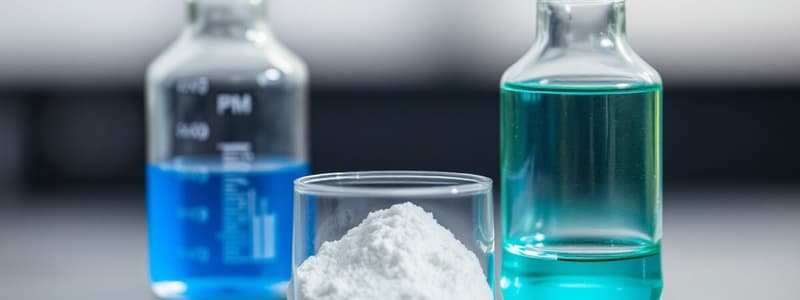Podcast
Questions and Answers
Which statement accurately describes the relationship between mass and weight?
Which statement accurately describes the relationship between mass and weight?
- Mass is the force created by gravity, while weight measures an object's resistance to change in motion.
- Mass is a measure of an object's inertia, while weight is the force created by gravity on a substance. (correct)
- Mass and weight are equivalent measurements and can be used interchangeably in scientific calculations.
- Weight is proportional to an object's inertia, while mass is solely determined by its volume.
Which of the following statements accurately describes an atom?
Which of the following statements accurately describes an atom?
- An atom is a subatomic particle with a positive electric charge.
- An atom is the basic building block of elements, but not of compounds.
- An atom is composed of protons and neutrons, but can gain or lose electrons.
- An atom is the smallest unit of matter that retains the chemical properties of an element. (correct)
What distinguishes an element from other types of atoms?
What distinguishes an element from other types of atoms?
- Its uniquely identifiable number of protons in the nucleus. (correct)
- Its ability to form ionic bonds with other atoms.
- Its unique arrangement of electrons in the nucleus.
- Its capacity to exist in multiple states of matter.
What is the key difference between covalent and ionic bonds?
What is the key difference between covalent and ionic bonds?
Which statement best describes the nature of molecules?
Which statement best describes the nature of molecules?
What distinguishes intensive properties of matter from extensive properties?
What distinguishes intensive properties of matter from extensive properties?
What is the key difference between a physical property and a chemical property?
What is the key difference between a physical property and a chemical property?
Which of the following indicates that a chemical change has likely occurred?
Which of the following indicates that a chemical change has likely occurred?
What characterizes a pure substance compared to a mixture?
What characterizes a pure substance compared to a mixture?
In a homogeneous mixture, what is a key characteristic?
In a homogeneous mixture, what is a key characteristic?
Which statement accurately describes a heterogeneous mixture?
Which statement accurately describes a heterogeneous mixture?
How does a colloidal dispersion differ from a coarse suspension?
How does a colloidal dispersion differ from a coarse suspension?
Which type of colloidal system describes cream or mayonnaise?
Which type of colloidal system describes cream or mayonnaise?
Which of the following best describes a liquid sol?
Which of the following best describes a liquid sol?
In what key way do compounds differ from homogenous mixtures (solutions)?
In what key way do compounds differ from homogenous mixtures (solutions)?
What is the key distinction between solutions, colloidal dispersions, and coarse suspensions based on particle size?
What is the key distinction between solutions, colloidal dispersions, and coarse suspensions based on particle size?
What is the key characteristic of the Tyndall effect, and which type of mixture exhibits it?
What is the key characteristic of the Tyndall effect, and which type of mixture exhibits it?
Which statement accurately compares the ability to separate components by filtration among different types of mixtures?
Which statement accurately compares the ability to separate components by filtration among different types of mixtures?
Based on the classification of matter, which of the following is considered a compound?
Based on the classification of matter, which of the following is considered a compound?
Which of the following mixtures could be most easily separated using a magnet?
Which of the following mixtures could be most easily separated using a magnet?
In the context of classifying matter, how would you classify copper?
In the context of classifying matter, how would you classify copper?
Classify wine based on its composition.
Classify wine based on its composition.
Solid, liquid, and gas are the common states of matter. What is the fourth state of matter?
Solid, liquid, and gas are the common states of matter. What is the fourth state of matter?
Which of the following properties are properties of solids?
Which of the following properties are properties of solids?
Which type of matter is created by adding so much energy to a gas that some of its electrons leave its atoms?
Which type of matter is created by adding so much energy to a gas that some of its electrons leave its atoms?
What happens to the identity of matter during a Physical Change?
What happens to the identity of matter during a Physical Change?
What can you observe that indicates a chemical change is taking place?
What can you observe that indicates a chemical change is taking place?
What is a mixture that consists of two or more substances mixed together without any chemical bond?
What is a mixture that consists of two or more substances mixed together without any chemical bond?
Homogeneous mixture is uniform, which means which of the following?
Homogeneous mixture is uniform, which means which of the following?
Coarse Suspensions- if which of the following occurs?
Coarse Suspensions- if which of the following occurs?
Which of the following can separate a compound into its constituent elements?
Which of the following can separate a compound into its constituent elements?
Flashcards
What is Matter?
What is Matter?
Anything that occupies space and has mass.
What is Mass?
What is Mass?
A measure of an object's inertia; proportional to weight.
What is Weight?
What is Weight?
The force created by gravity on a substance.
What is an Atom?
What is an Atom?
Signup and view all the flashcards
What is a Proton?
What is a Proton?
Signup and view all the flashcards
What is a Neutron?
What is a Neutron?
Signup and view all the flashcards
What is an Electron?
What is an Electron?
Signup and view all the flashcards
What is an Element?
What is an Element?
Signup and view all the flashcards
What is a Compound?
What is a Compound?
Signup and view all the flashcards
What is a Covalent Bond?
What is a Covalent Bond?
Signup and view all the flashcards
What is an Ionic Bond?
What is an Ionic Bond?
Signup and view all the flashcards
What is a Molecule?
What is a Molecule?
Signup and view all the flashcards
What are Intensive Properties?
What are Intensive Properties?
Signup and view all the flashcards
What are Extensive Properties?
What are Extensive Properties?
Signup and view all the flashcards
What are Physical Properties?
What are Physical Properties?
Signup and view all the flashcards
What are Chemical Properties?
What are Chemical Properties?
Signup and view all the flashcards
What is a Solid?
What is a Solid?
Signup and view all the flashcards
What is a Liquid?
What is a Liquid?
Signup and view all the flashcards
What is a Gas?
What is a Gas?
Signup and view all the flashcards
What is Plasma?
What is Plasma?
Signup and view all the flashcards
What is Physical Change?
What is Physical Change?
Signup and view all the flashcards
What is Chemical Change?
What is Chemical Change?
Signup and view all the flashcards
What is an Element (Classification)?
What is an Element (Classification)?
Signup and view all the flashcards
What is a Compound (Classification)?
What is a Compound (Classification)?
Signup and view all the flashcards
What is a Mixture?
What is a Mixture?
Signup and view all the flashcards
What is a Homogeneous Mixture?
What is a Homogeneous Mixture?
Signup and view all the flashcards
What is a Heterogeneous Mixture?
What is a Heterogeneous Mixture?
Signup and view all the flashcards
What are Coarse Suspensions?
What are Coarse Suspensions?
Signup and view all the flashcards
What is Colloidal Dispersion?
What is Colloidal Dispersion?
Signup and view all the flashcards
What is Liquid Foam?
What is Liquid Foam?
Signup and view all the flashcards
What is Solid Foam?
What is Solid Foam?
Signup and view all the flashcards
What is Liquid Aerosol?
What is Liquid Aerosol?
Signup and view all the flashcards
What is Emulsion?
What is Emulsion?
Signup and view all the flashcards
What is Solid Emulsion?
What is Solid Emulsion?
Signup and view all the flashcards




